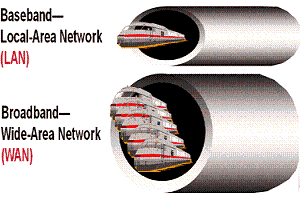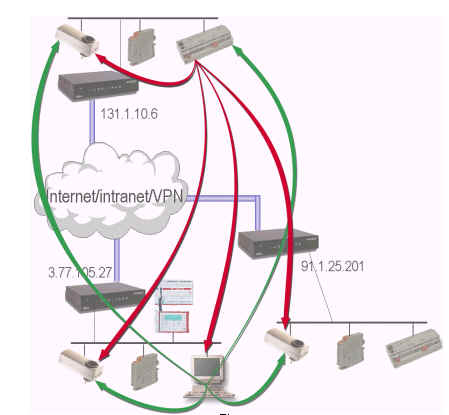Many issues impact network performance besides the hardware topology. To identify them, you have to ask the right questions.
Q Full duplex vs. half duplex vs. simplex—Can the nodes talk and listen simultaneously?
Devices that can talk and listen at the same time (e.g., telephones) are full-duplex devices. Citizen Band (CB) and other radio formats are normally half duplex—meaning they can talk and listen, but not simultaneously.

Q Full duplex vs. half duplex vs. simplex—Can the nodes talk and listen simultaneously?
Devices that can talk and listen at the same time (e.g., telephones) are full-duplex devices. Citizen Band (CB) and other radio formats are normally half duplex—meaning they can talk and listen, but not simultaneously.

In this case, some indication is usually required to let the other party know it’s okay to talk (e.g., by saying “over”). RS-232 is a half-duplex data bus, and Ethernet is a full-duplex connection. Many modern devices can simulate full-duplex performance by switching between transmit and receive fast enough (in milliseconds) that humans can’t perceive the delay. Most cell phones are implemented with this fast switching strategy. Simplex systems communicate in one direction only. Half-duplex systems operate like simplex systems and then reverse the roles of transmitter and receiver.
Q Analog vs. digital—In what form does the signal enter the hardware medium?
In analog systems, the modulation technique is continuously variable (e.g., voice). Digital systems use an A/D converter to digitize the signal and send a data packet that uses 1s and 0s to represent the analog value.

Digital transmissions offer such advantages as reduced fading, reduced noise, and increased throughput. Analog systems potentially have better resolution, though, because no digitization error is involved. In the old analog telephone systems, the voice modulated the electrical resistance and thus the voltage across the carbon granules packed in the mouthpiece. Digital systems replaced the old analog phone circuits many years ago, except for the phone line from your phone to the first switching station. The 4–20 mA system is an analog channel, and RS-232 and Ethernet are digital.
Q Baseband vs. broadband—Should you use a carrier to increase the number of channels that can be put on the network medium?
If the signal containing information is placed directly on the physical medium, the channel is called baseband. If the signal is placed on a carrier (modulation), the channel is broadband. Because many carriers can be placed on the same medium at different frequencies, a given hardware channel can carry many logical channels. Cable TV is a broadband network, with each TV channel on a different carrier frequency.

The TV channel designates the carrier frequency. Optical fibers now carry many more channels than once thought possible by modulating information onto the fiber at different frequencies of the light (colors).
Broadband systems are usually more complicated, so the tradeoff must be made with care. Standard Ethernet is a baseband bus, but wireless (radio) buses are usually broadband.
Q Master-slave vs. peer-to-peer vs. broadcast—How should the nodes interact with each other and with the host?
In master-slave protocols, one node gives the commands, and another node or collection of nodes executes them. The host is usually the master, and the sensors and actuators are usually slaves. This protocol allows tight traffic control because no node is allowed to speak unless requested by the master, and no communication is allowed between slaves except through the master.
Q Master-slave vs. peer-to-peer vs. broadcast—How should the nodes interact with each other and with the host?
In master-slave protocols, one node gives the commands, and another node or collection of nodes executes them. The host is usually the master, and the sensors and actuators are usually slaves. This protocol allows tight traffic control because no node is allowed to speak unless requested by the master, and no communication is allowed between slaves except through the master.
In a peer-to-peer network, all nodes are created equal. A node can be a master one moment and then be reconfigured at another time. Peer-to-peer configurations offer the greatest flexibility, but they’re the most difficult to control. Any node can communicate directly with any other node.
Broadcast networks are much like master-slave configurations, but the master can send commands to more than one slave at a time. Many industrial protocols (e.g., IEEE-1451) are based on master-slave (with broadcast) protocols. Wireless systems can be implemented in any of these protocols.
Q Circuit switched vs. packet switched—How long should a node own a communications channel?
Again, the old analog phone system is used as an example. These systems were circuit-switched networks. You dialed the number, and a circuit was established between the sender and the receiver. The circuit stayed connected as long as the phone call continued. When the parties hung up, the circuit was released and available for another connection.

Broadcast networks are much like master-slave configurations, but the master can send commands to more than one slave at a time. Many industrial protocols (e.g., IEEE-1451) are based on master-slave (with broadcast) protocols. Wireless systems can be implemented in any of these protocols.
Q Circuit switched vs. packet switched—How long should a node own a communications channel?
Again, the old analog phone system is used as an example. These systems were circuit-switched networks. You dialed the number, and a circuit was established between the sender and the receiver. The circuit stayed connected as long as the phone call continued. When the parties hung up, the circuit was released and available for another connection.

Packet-switched networks route digital packets of information as they travel along different paths throughout the network. Each packet contains routing information so that the receiver can reassemble the packets into a complete message when they arrive. Complexity is high, but the potential for flexibility and improved channel use is also high. The Internet and World Wide Web are based on packet-switched networks.n

No comments:
Post a Comment